Short Beam Shear Behavior and Failure Characterization of Hybrid 3D Braided Composites Structure with X-ray Micro-Computed Tomography
Abstract
1. Introduction
2. Materials and Methods
2.1. Materials and Sample Preparation
2.2. Tests
2.3. Water-Logging Ultrasonic Scanning Testing
2.4. Micro-CT Image Acquisition
3. Results and Discussions
3.1. Mechanical Behavior
3.2. Damage Morphology Analyses
3.3. Water-Logging Ultrasonic Imaging Analyses
3.4. Micro-CT Tomography Analyses
4. Conclusions
Author Contributions
Funding
Conflicts of Interest
References
- Gu, Q.; Quan, Z.; Yu, J.; Yan, J.; Sun, B.; Xu, G. Structural modeling and mechanical characterizing of three-dimensional four-step braided composites: A review. Compos. Struct. 2019, 207, 119–128. [Google Scholar] [CrossRef]
- Wu, L.; Zhang, F.; Sun, B.; Gu, B. Finite element analyses on three-point low-cyclic bending fatigue of 3-d braided composite materials at microstructure level. Int. J. Mech. Sci. 2014, 84, 41–53. [Google Scholar] [CrossRef]
- Luo, H.; Xiong, G.; Yang, Z.; Raman, S.R.; Li, Q.; Ma, C.; Li, D.; Wang, Z.; Wan, Y. Preparation of three-dimensional braided carbon fiber-reinforced peek composites for potential load-bearing bone fixations. Part i. Mechanical properties and cytocompatibility. J. Mech. Behav. Biomed. Mater. 2014, 29, 103–113. [Google Scholar] [CrossRef]
- Xiang, D.; Wang, L.; Tang, Y.; Harkin-Jones, E.; Zhao, C.; Wang, P.; Li, Y. Damage self-sensing behavior of carbon nanofiller reinforced polymer composites with different conductive network structures. Polymer 2018, 158, 308–319. [Google Scholar] [CrossRef]
- Khosravani, M.R.; Weinberg, K. Experimental investigations of the environmental effects on stability and integrity of composite sandwich t-joints. Mater. Und Werkst. 2017, 48, 753–759. [Google Scholar] [CrossRef]
- Singh, T.J.; Samanta, S. Characterization of kevlar fiber and its composites: A review. Mater. Today Proc. 2015, 2, 1381–1387. [Google Scholar] [CrossRef]
- Wu, L.; Wang, W.; Jiang, Q.; Lin, J.-H.; Tang, Y. Illustrating hybrid effect and damage evolution of carbon/aramid braided composite under low-velocity impact. Compos. Struct. 2020, 245, 112372. [Google Scholar] [CrossRef]
- Jawaid, M.; Abdul Khalil, H.P.S.; Abu Bakar, A. Woven hybrid composites: Tensile and flexural properties of oil palm-woven jute fibres based epoxy composites. Mater. Sci. Eng. A 2011, 528, 5190–5195. [Google Scholar] [CrossRef]
- Swolfs, Y.; McMeeking, R.M.; Rajan, V.P.; Zok, F.W.; Verpoest, I.; Gorbatikh, L. Global load-sharing model for unidirectional hybrid fibre-reinforced composites. J. Mech. Phys. Solids 2015, 84, 380–394. [Google Scholar] [CrossRef]
- Zheng, Y.; Sun, Y.; Li, J.; Limin, L.; Chen, L.; Liu, J.; Tian, S. Tensile response of carbon-aramid hybrid 3d braided composites. Mater. Des. 2017, 116, 246–252. [Google Scholar] [CrossRef]
- Wu, L.; Wang, W.; Jiang, Q.; Xiang, C.; Lou, C.W. Mechanical characterization and impact damage assessment of hybrid three-dimensional five-directional composites. Polymers (Basel) 2019, 11, 1395. [Google Scholar] [CrossRef] [PubMed]
- Zhang, P.-F.; Zhou, W.; Yin, H.-F.; Shang, Y.-J. Progressive damage analysis of three-dimensional braided composites under flexural load by micro-ct and acoustic emission. Compos. Struct. 2019, 226, 111196. [Google Scholar] [CrossRef]
- Zhang, D.; Waas, A.M.; Yen, C.-F. Progressive damage and failure response of hybrid 3d textile composites subjected to flexural loading, part i: Experimental studies. Int. J. Solids Struct. 2015, 75–76, 309–320. [Google Scholar] [CrossRef]
- Murugan, R.; Ramesh, R.; Padmanabhan, K. Investigation on static and dynamic mechanical properties of epoxy based woven fabric glass/carbon hybrid composite laminates. Procedia Eng. 2014, 97, 459–468. [Google Scholar] [CrossRef]
- Godani, M.; Gaiotti, M.; Rizzo, C.M. Interlaminar shear strength of marine composite laminates: Tests and numerical simulations. Compos. Struct. 2014, 112, 122–133. [Google Scholar] [CrossRef]
- Albahash, Z.F.; Ansari, M.N.M. Investigation on energy absorption of natural and hybrid fiber under axial static crushing. Compos. Sci. Technol. 2017, 151, 52–61. [Google Scholar] [CrossRef]
- He, C.; Ge, J.; Zhang, B.; Gao, J.; Zhong, S.; Liu, W.K.; Fang, D. A hierarchical multiscale model for the elastic-plastic damage behavior of 3d braided composites at high temperature. Compos. Sci. Technol. 2020, 196, 108230. [Google Scholar] [CrossRef]
- Liu, G.; Zhang, L.; Guo, L.C.; Wang, Q.M.; Liao, F. A modified v-notched beam test method for interlaminar shear behavior of 3d woven composites. Compos. Struct. 2017, 181, 46–57. [Google Scholar] [CrossRef]
- Nayak, R.K.; Rathore, D.; Ray, B.C.; Routara, B.C. Inter laminar shear strength (ilss) of nano al2o3 filled glass fiber reinforced polymer (gfrp) composite—A study on loading rate sensitivity. Mater. Today Proc. 2017, 4, 8688–8696. [Google Scholar] [CrossRef]
- Xiao, S.; Wang, P.; Soulat, D.; Minet, J.; Zemni, L.; Gao, H. Analysis of the in-plane shear behaviour of non-orthogonally textile reinforcements: Application to braided fabrics. Compos. Part B Eng. 2018, 153, 159–166. [Google Scholar] [CrossRef]
- Ahmad, M.A.A.; Abdul Majid, M.S.; Ridzuan, M.J.M.; Mazlee, M.N.; Gibson, A.G. Dynamic mechanical analysis and effects of moisture on mechanical properties of interwoven hemp/polyethylene terephthalate (pet) hybrid composites. Constr. Build. Mater. 2018, 179, 265–276. [Google Scholar] [CrossRef]
- Gereke, T.; Cherif, C. A review of numerical models for 3d woven composite reinforcements. Compos. Struct. 2019, 209, 60–66. [Google Scholar] [CrossRef]
- Cui, C.; Dong, J.; Mao, X. Effect of braiding angle on progressive failure and fracture mechanism of 3-d five-directional carbon/epoxy braided composites under impact compression. Compos. Struct. 2019, 229, 111412. [Google Scholar] [CrossRef]
- Ge, J.; He, C.; Liang, J.; Chen, Y.; Fang, D. A coupled elastic-plastic damage model for the mechanical behavior of three-dimensional (3d) braided composites. Compos. Sci. Technol. 2018, 157, 86–98. [Google Scholar] [CrossRef]
- Liu, X.; Zhang, D.; Sun, J.; Yu, S.; Dai, Y.; Zhang, Z.; Sun, J.; Li, G.; Qian, K. Refine reconstruction and verification of meso-scale modeling of three-dimensional five-directional braided composites from x-ray computed tomography data. Compos. Struct. 2020, 245, 112347. [Google Scholar] [CrossRef]
- Zhou, H.; Li, C.; Zhang, L.; Crawford, B.; Milani, A.S.; Ko, F.K. Micro-xct analysis of damage mechanisms in 3d circular braided composite tubes under transverse impact. Compos. Sci. Technol. 2018, 155, 91–99. [Google Scholar] [CrossRef]
- Ya, J.; Liu, Z.; Wang, Y. Micro-ct characterization on the meso-structure of three-dimensional full five-directional braided composite. Appl. Compos. Mater. 2016, 24, 593–610. [Google Scholar] [CrossRef]
- Khosravani, M.R. Composite materials manufacturing processes. Appl. Mech. Mater. 2012, 110–116, 1361–1367. [Google Scholar] [CrossRef]
- Makeev, A.; He, Y.; Schreier, H. Short-beam shear method for assessment of stress–strain curves for fibre-reinforced polymer matrix composite materials. Strain 2013, 49, 440–450. [Google Scholar] [CrossRef]
- Garcea, S.C.; Wang, Y.; Withers, P.J. X-ray computed tomography of polymer composites. Compos. Sci. Technol. 2018, 156, 305–319. [Google Scholar] [CrossRef]
- Meza, L.R.; Schormans, J.M.J.; Remmers, J.J.C.; Deshpande, V.S. Shear response of 3d non-woven carbon fibre reinforced composites. J. Mech. Phys. Solids 2019, 125, 276–297. [Google Scholar] [CrossRef]
- Zhang, D.; Liu, X.; Gu, Y.; Sun, M.; Yu, S.; Zhang, Y.; Qian, K. Effects of off-axis angle on shear progressive damage of 3d woven composites with x-ray micro-computed tomography. Compos. Part A Appl. Sci. Manuf. 2018, 115, 311–320. [Google Scholar] [CrossRef]
- Tian, Z.; Yan, Y.; Li, J.; Hong, Y.; Guo, F. Progressive damage and failure analysis of three-dimensional braided composites subjected to biaxial tension and compression. Compos. Struct. 2018, 185, 496–507. [Google Scholar] [CrossRef]
- Lu, Y. Non-Destructive Evaluation on Concrete Materials and Structures Using Cement-Based Piezoelectric Sensor. Ph.D Thesis, The Hong Kong University of Science and Technology, Clear Water Bay, Hong Kong, 2010. [Google Scholar]
- Segreto, T.; Bottillo, A.; Teti, R. Advanced ultrasonic non-destructive evaluation for metrological analysis and quality assessment of impact damaged non-crimp fabric composites. Procedia CIRP 2016, 41, 1055–1060. [Google Scholar] [CrossRef]
- Aymerich, F.; Meili, S. Ultrasonic evaluation of matrix damage in impacted composite laminates. Compos. Part B-Eng. 2000, 31, 1–6. [Google Scholar] [CrossRef]
- Bull, D.J.; Helfen, L.; Sinclair, I.; Spearing, S.M.; Baumbach, T. A comparison of multi-scale 3d x-ray tomographic inspection techniques for assessing carbon fibre composite impact damage. Compos. Sci. Technol. 2013, 75, 55–61. [Google Scholar] [CrossRef]
- Dong, C.; Davies, I.J. Effect of stacking sequence on the flexural properties of carbon and glass fibre-reinforced hybrid composites. Adv. Compos. Hybrid Mater. 2018, 1, 530–540. [Google Scholar] [CrossRef]
- Wang, R.; Zhang, L.; Hu, D.; Liu, X.; Cho, C.; Li, B. Progressive damage simulation in 3d four-directional braided composites considering the jamming-action-induced yarn deformation. Compos. Struct. 2017, 178, 330–340. [Google Scholar] [CrossRef]
- Li, Y.; Sun, B.; Gu, B. Impact shear damage characterizations of 3d braided composite with x-ray micro-computed tomography and numerical methodologies. Compos. Struct. 2017, 176, 43–54. [Google Scholar] [CrossRef]
- Wan, Y.; Straumit, I.; Takahashi, J.; Lomov, S.V. Micro-ct analysis of internal geometry of chopped carbon fiber tapes reinforced thermoplastics. Compos. Part A Appl. Sci. Manuf. 2016, 91, 211–221. [Google Scholar] [CrossRef]
- Li, X. Eddy Current Techniques for Non-Destructive Testing of Carbon Fibre Reinforced Plastic (CFRP); University of Manchester: Manchester, UK, 2012. [Google Scholar]
- Huang, N.C.; Liu, X.Y. Debonding and fiber pull-out in reinforced composites. Theor. Appl. Fract. Mech. 1994, 21, 157–176. [Google Scholar] [CrossRef]
- Sebaey, T.A.; Catalanotti, G.; O’Dowd, N.P. A microscale integrated approach to measure and model fibre misalignment in fibre-reinforced composites. Compos. Sci. Technol. 2019, 183, 107793. [Google Scholar] [CrossRef]
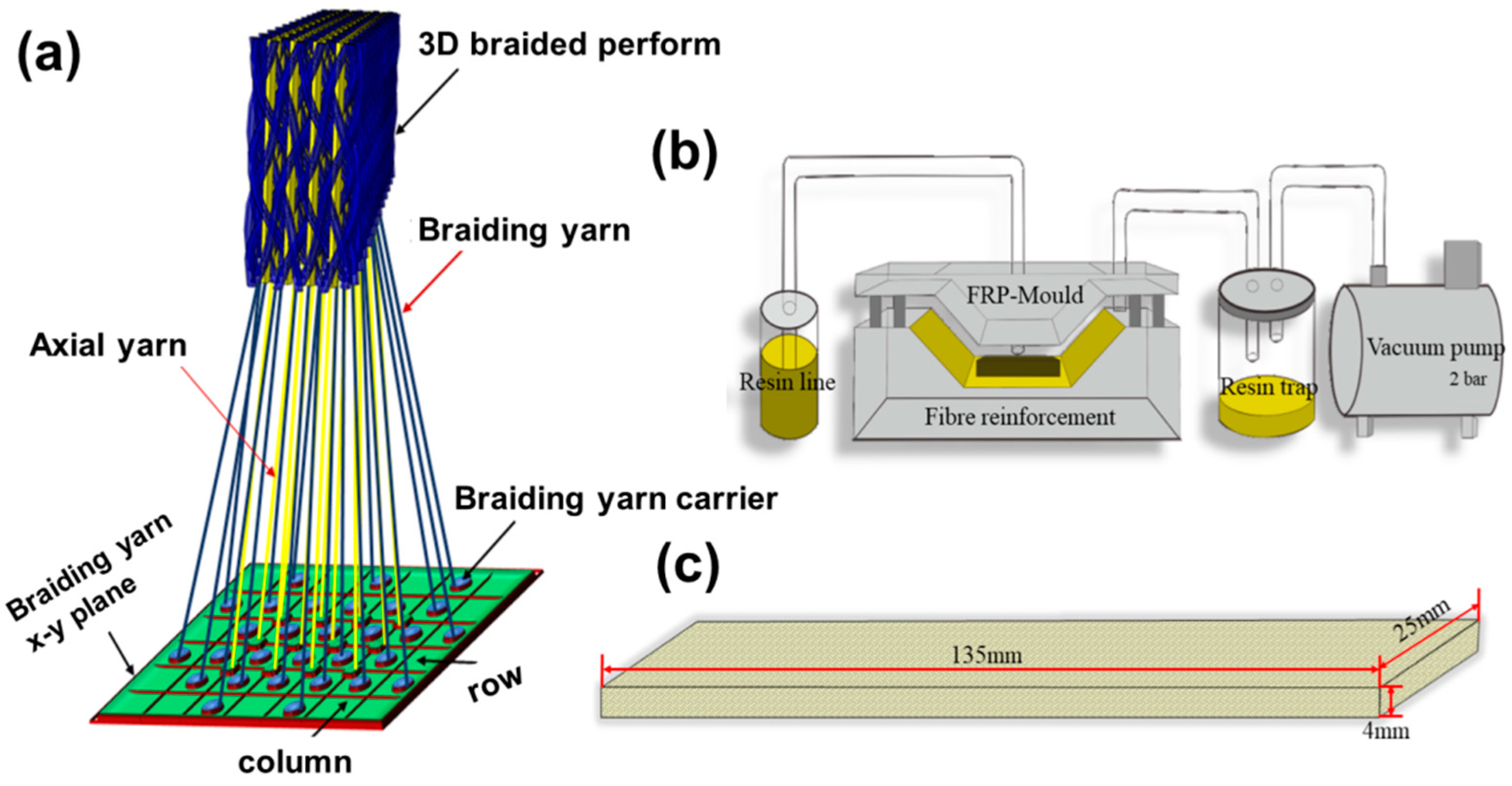

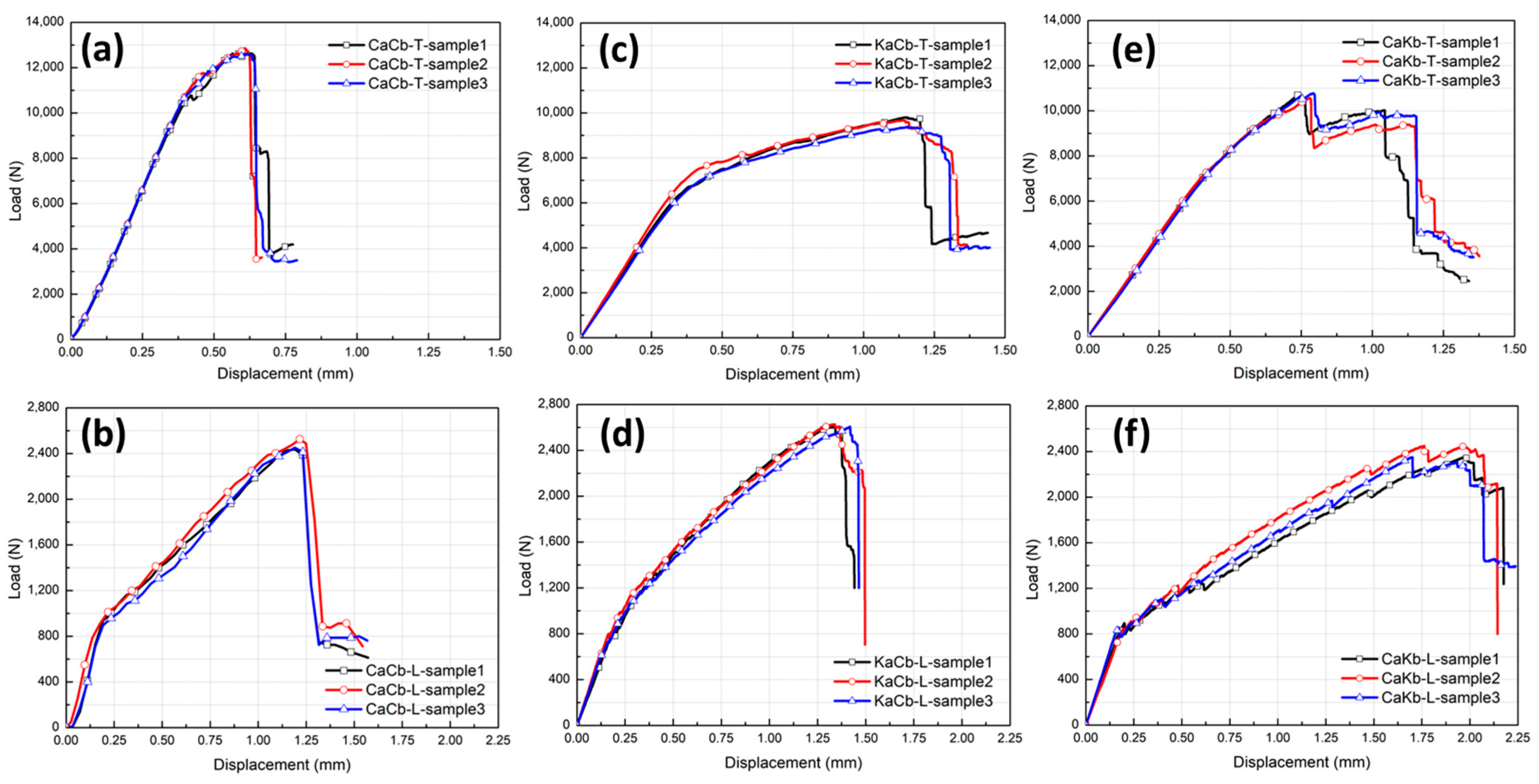

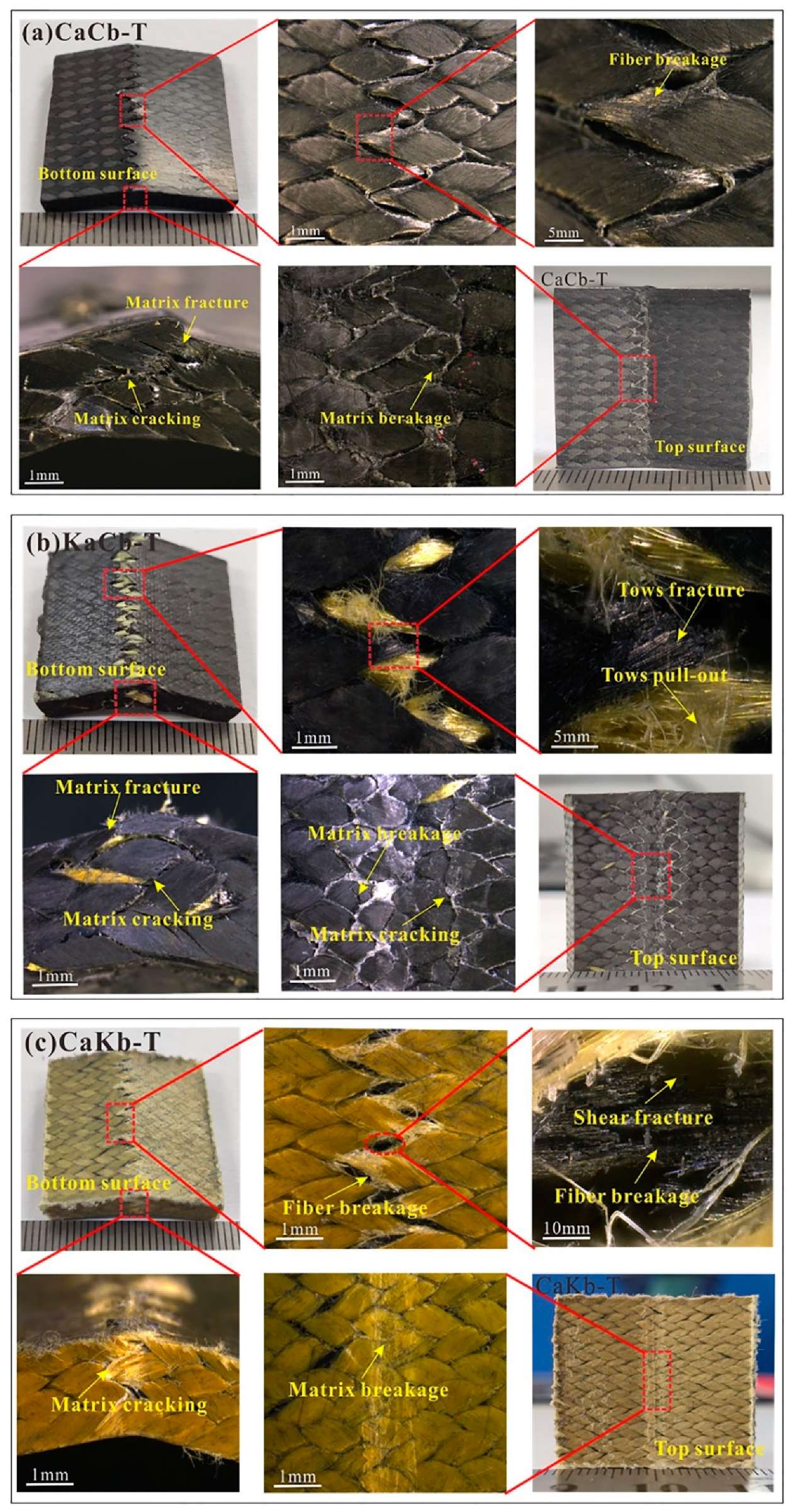



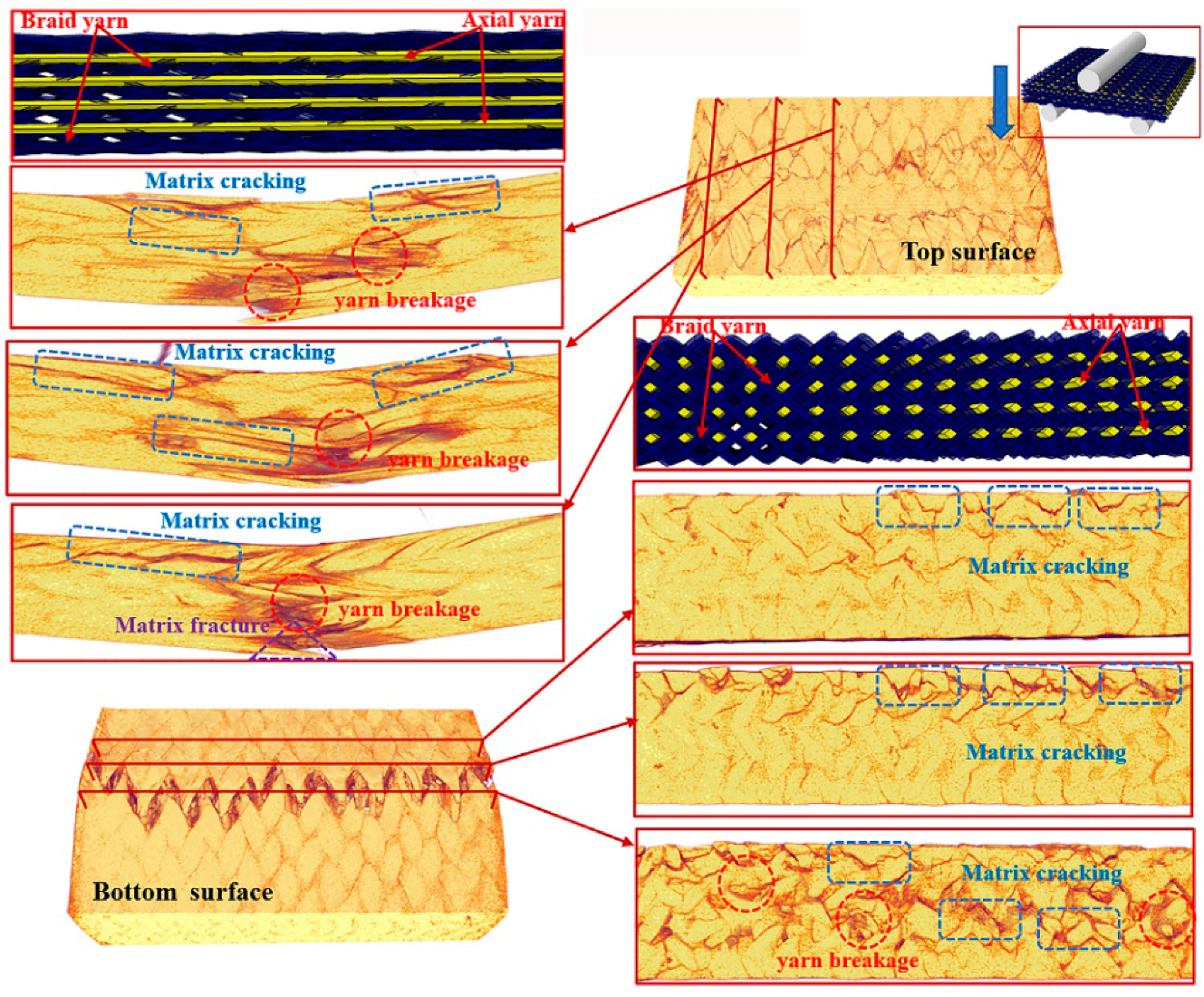
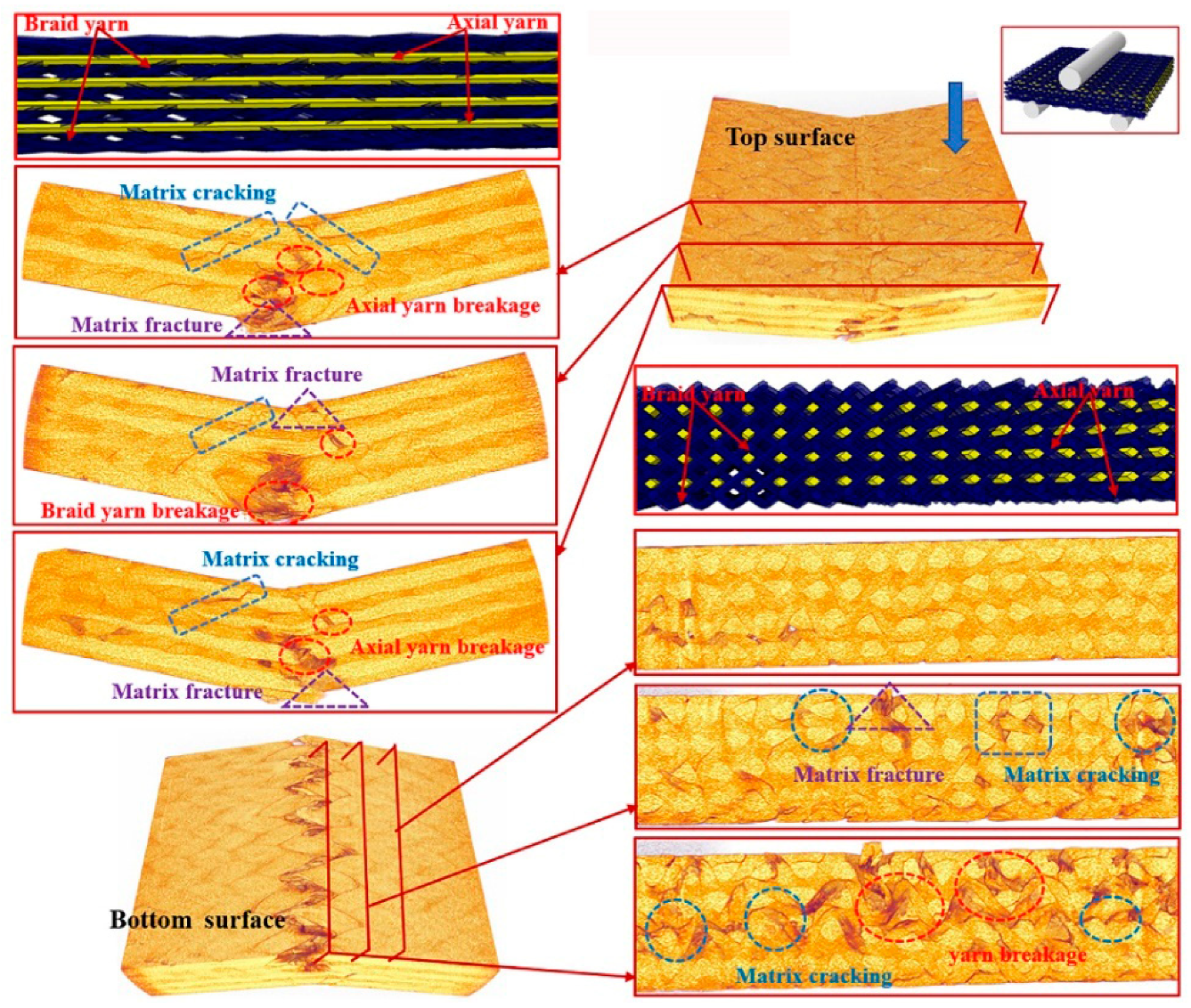
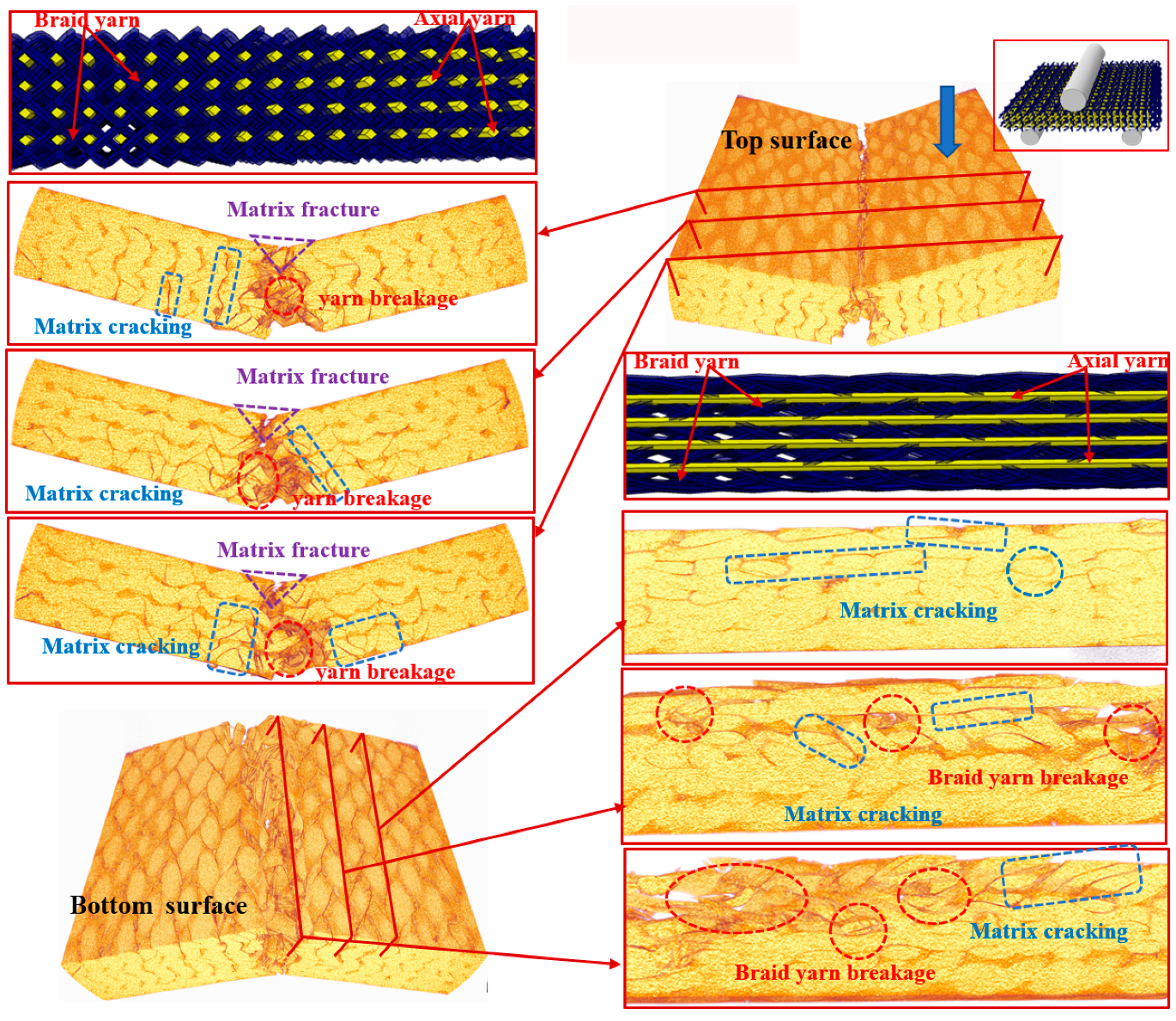
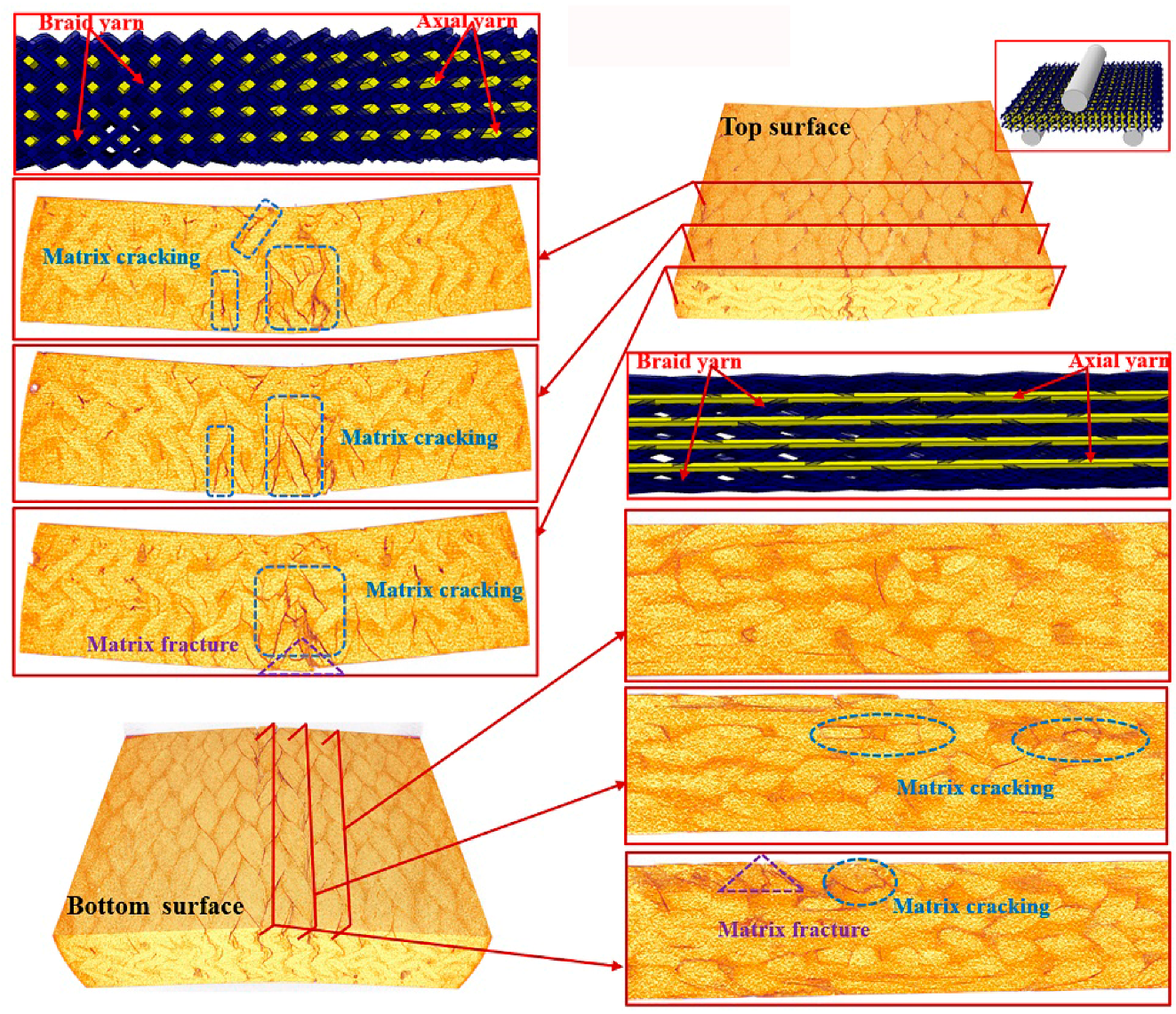
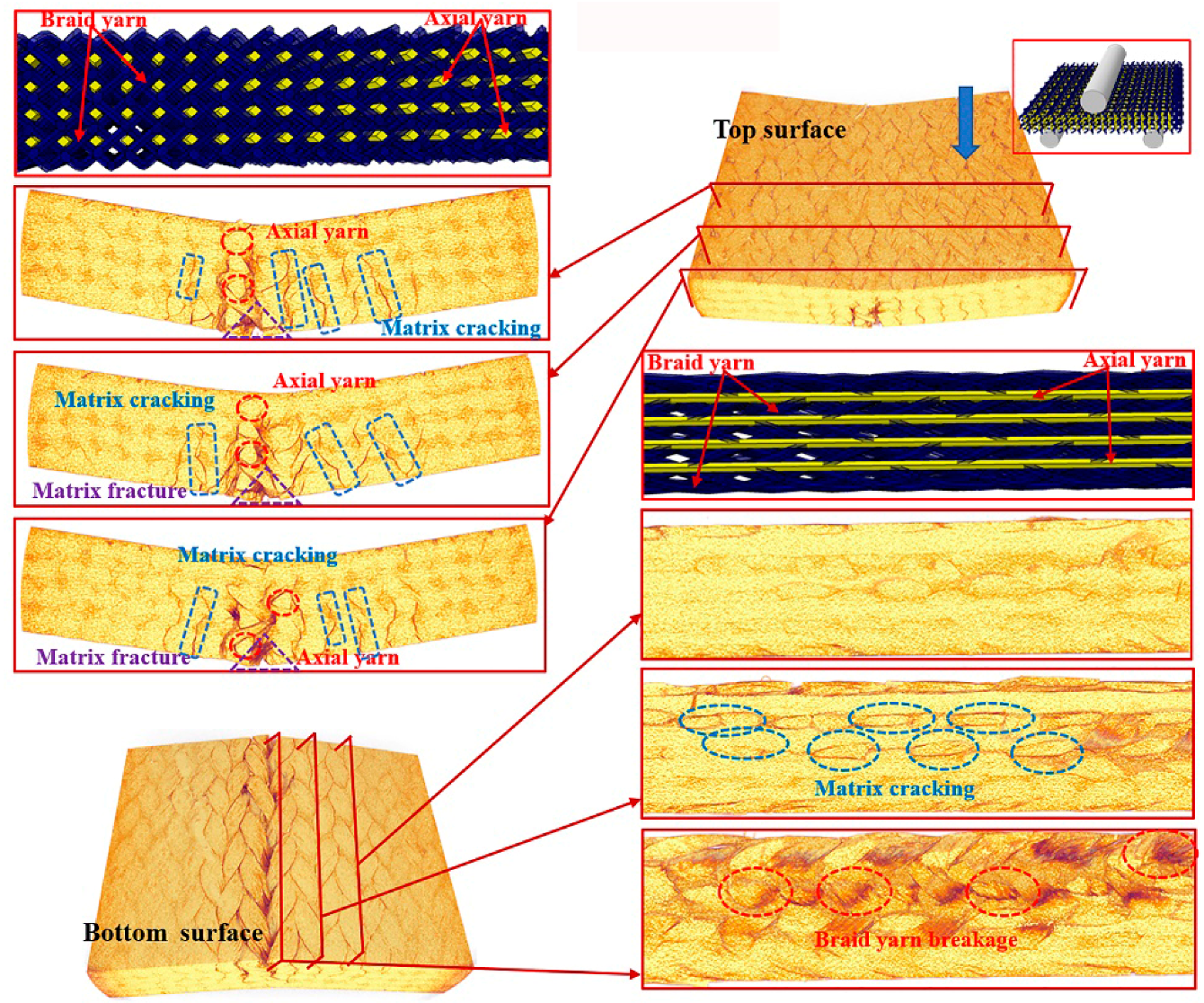
| Materials | Type | Strength (MPa) | Modulus (GPa) | Density (g/cm3) | Elongation (%) |
|---|---|---|---|---|---|
| Carbon fiber | T300-3K | 3530 | 230 | 1.76 | 1.5 |
| Aramid fiber | Kevlar49 | 2923 | 95 | 1.44 | 2.8 |
| Resin | TDE-86 | 80 | 3.5 | 1.13 | 4.0 |
| Type | Axial | Braid | Pick Length (mm) | Pick Width (mm) | Yarn Volume Content (%) |
|---|---|---|---|---|---|
| CaCb | T300-3K | T300-3K | 25 ± 0.1 | 25 ± 0.1 | T300-3K:53% |
| CaKb | T300-3K | Kevlar49 | 25 ± 0.1 | 25 ± 0.1 | Kevlar49:11%, T300-3K:43% |
| KaCb | Kevlar49 | T300-3K | 25 ± 0.1 | 25 ± 0.1 | Kevlar49:43%, T300-3K:11% |
© 2020 by the authors. Licensee MDPI, Basel, Switzerland. This article is an open access article distributed under the terms and conditions of the Creative Commons Attribution (CC BY) license (http://creativecommons.org/licenses/by/4.0/).
Share and Cite
Wu, L.; Sun, X.; Xiang, C.; Wang, W.; Zhang, F.; Jiang, Q.; Tang, Y.; Lin, J.-H. Short Beam Shear Behavior and Failure Characterization of Hybrid 3D Braided Composites Structure with X-ray Micro-Computed Tomography. Polymers 2020, 12, 1931. https://doi.org/10.3390/polym12091931
Wu L, Sun X, Xiang C, Wang W, Zhang F, Jiang Q, Tang Y, Lin J-H. Short Beam Shear Behavior and Failure Characterization of Hybrid 3D Braided Composites Structure with X-ray Micro-Computed Tomography. Polymers. 2020; 12(9):1931. https://doi.org/10.3390/polym12091931
Chicago/Turabian StyleWu, Liwei, Xiaojun Sun, Chunjie Xiang, Wei Wang, Fa Zhang, Qian Jiang, Youhong Tang, and Jia-Horng Lin. 2020. "Short Beam Shear Behavior and Failure Characterization of Hybrid 3D Braided Composites Structure with X-ray Micro-Computed Tomography" Polymers 12, no. 9: 1931. https://doi.org/10.3390/polym12091931
APA StyleWu, L., Sun, X., Xiang, C., Wang, W., Zhang, F., Jiang, Q., Tang, Y., & Lin, J.-H. (2020). Short Beam Shear Behavior and Failure Characterization of Hybrid 3D Braided Composites Structure with X-ray Micro-Computed Tomography. Polymers, 12(9), 1931. https://doi.org/10.3390/polym12091931








